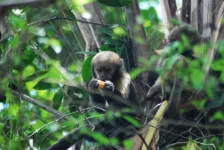An article reporting the findings of the study is published in the American Journal of Primatology.
"Many theories in the field of primatology assume that pressure to find food is more important that predation pressure. In this study we were able to show that predation pressure in Una counts for more in deciding where to be than where food is most abundant. These animals spend less time where food is plentiful because they perceive a higher risk of predation there. Another very important point is that this risk isn't posed only by natural predators but also by human predators - by poachers. Because of hunting pressure, they spend less time in places where the most food is available," said Patrícia Izar, last author of the article. Izar is a professor in the Department of Experimental Psychology at the University of São Paulo's Institute of Psychology (IP-USP).
The study was part of a research project by Priscila Suscke, first author of the article, for her PhD in Una, which according to the researchers contains "a mosaic of habitats" including three predominant types of vegetation: mature forest, secondary forest, and an agroforestry system known as cabruca, in which cacao trees introduced to replace the understory thrive in the shade of the native forest.
"It's not that food doesn't influence use of the area, but that in these different forest landscape environments in the Una Biological Reserve each environment contributes different amounts of food, and each poses a different level of risk [in terms of predation and poaching]," Suscke said."Our analysis of the factors influencing the monkeys' use of these three environments showed that the group avoided the area with the largest food supply because of the risk involved."
The study was supported by São Paulo Research Foundation - FAPESP via a PhD scholarship awarded to Suscke and a Regular Research Grant awarded to Izar."All my research on primates for the past 20 years has been basically funded by FAPESP, although I've had support from other agencies," Izar said.
Data collection
To collect field data, Izar and three trained observers watched the group of capuchin monkeys, which varied between 32 and 37 individuals. They followed the group simultaneously and began collecting data only when interobserver agreement accuracy reached 85%. The training period lasted about three months. All observations were recorded with the aid of a GPS unit, so that all reported occurrences were georeferenced.
"In estimating the area actually used by the animals for survival, which was smaller than the area of the conservation unit, we took into account all georeferenced points, including foraging and sleeping sites," explained geographer Andrea Presotto, second author of the article and a professor in the Department of Geography and Geosciences at Salisbury University in the United States.
The researchers observed foraging behavior using fruit left on aluminum trays anchored to the ground and traps in the form of shallow pits into which invertebrates fell and out of which they were unable to climb.
Other behaviors besides feeding, such as resting, traveling, interacting with other monkeys, keeping watch, and so on, were recorded every 15 minutes for each individual. To reflect risk perception, the researchers noted alarm calls and vigilance behavior in each habitat, also georeferenced. The animals' reactions to the alarms were the basis for an analysis of perceived predation risk and its influence on their behavior.
"The study cross-referenced the data collected on foraging behavior, reactions to predators, and interactions with the environment, in conjunction with objective measurements of that environment, as well as food supply, and what we call absolute predation risk, based on the density of predators in the area," Izar said.
Landscape of fear
Presotto used the field data to produce maps for five spatial predation risk variables: hunting pressure, pressure from terrestrial or aerial predators, vigilance, and silence, each in relation to the three forest environments. This so-called "landscape of fear" approach consists of a visual model that helps explain how fear can change the use of an area by animals as they try to reduce their vulnerability to predation.
"The intensity of each variable was calculated in the GIS [geographic information system] using the kernel density method to estimate the number of occurrences in a specific area. For example, whenever an attack by an aerial predator was observed, the point was recorded using the GPS unit. The model told us where such occurrences occurred most," Presotto said.
The maps and statistical model produced by Presotto to display predation risk variables confirmed the group's initial hypotheses. "Evidence of hunting by humans was most abundant in the cabruca, but it was also found in the transition zones between mature and secondary forest and cabruca areas. Moreover, the monkeys were silent more frequently in the cabruca than in the other two landscapes. Perceived risk from terrestrial predators was strongest in secondary forest, and from aerial predators in cabruca and mature and secondary forest areas, especially transition zones. The monkeys were vigilant more frequently in the cabruca and a large secondary forest area," said Presotto, who is mounting a georeferenced database on the topic.
Reactions vary to different types of predator, Suscke noted. "What matters is perceived predation risk - how the prey perceives where in the landscape there's less or more risk of being predated," she said. "As we refined our analysis, we found that different predators affect the prey's perception and behavior differently, and we were able to make separate metrics for aerial and terrestrial predators, as well as poachers. We were also able to show the importance of hunting in determining the pattern of use of the area by these monkeys, and above all that the risk of being hunted negatively affected their use of the area."
The researchers are also studying capuchin monkeys in two other locations: Fazenda Boa Vista (Piauí state), and Carlos Botelho State Park (São Paulo state). "Because we have comparative studies, we can say that the monkeys in Una Biological Reserve display a higher predation risk perception in terms of more frequently occurring alarm behaviors, such as falling silent or freezing, and that these appear to be specific to hunting," Izar said, recalling that capuchin monkeys are naturally very noisy. "Our article points to yet another negative effect of anthropic pressure on animal behavior."
Monkeys are not pets
For Suscke, the article also points to thoughts about public policy. "Poaching has a major negative effect. Conservation units have been created for many years, and this is a commendable policy, but our findings point to the importance of proper surveillance in order to take good care of them," she said. "It's also important to educate the public, given the existence of recreational hunting as well as poaching, both opportunistically for food and systematically for animal trafficking. It's not uncommon to see monkeys kept as pets. In these cases, the poachers usually capture the mother and sell the infant. The Yellow-breasted capuchin is a critically endangered species, so the issue is hard to resolve and must be the object of tougher policies."
Izar stresses that the list of wild animals that can legally be sold as pets recently issued by Brazil's National Environmental Council (CONAMA) is a threat to primates. "The pressure on them is very strong in Brazil, and the Brazilian Primatology Society has launched a campaign entitled 'Monkeys Aren't Pets'. We know that legalization of the commercial breeding of wild animals leads to an increase in illegal trafficking of animals captured in their natural habitats, because commercially bred animals are much more expensive," she said.
INFORMATION:
About São Paulo Research Foundation (FAPESP)
The São Paulo Research Foundation (FAPESP) is a public institution with the mission of supporting scientific research in all fields of knowledge by awarding scholarships, fellowships and grants to investigators linked with higher education and research institutions in the State of São Paulo, Brazil. FAPESP is aware that the very best research can only be done by working with the best researchers internationally. Therefore, it has established partnerships with funding agencies, higher education, private companies, and research organizations in other countries known for the quality of their research and has been encouraging scientists funded by its grants to further develop their international collaboration. You can learn more about FAPESP at http://www.fapesp.br/en and visit FAPESP news agency at http://www.agencia.fapesp.br/en to keep updated with the latest scientific breakthroughs FAPESP helps achieve through its many programs, awards and research centers. You may also subscribe to FAPESP news agency at http://agencia.fapesp.br/subscribe.


